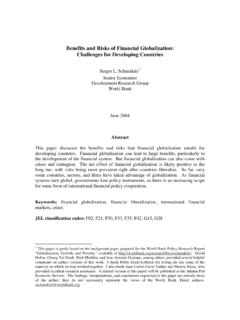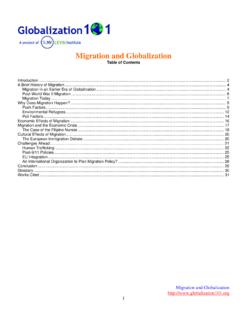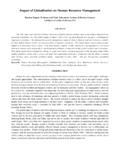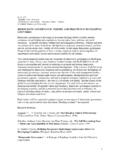Transcription of Technology, globalization, and international ...
1 29 Technology, globalization , and international competitiveness: Challenges for developing countriesCarl Dahlman*1. IntroductionThis paper traces the role of technology in economic growth and competitive-ness, summarizes the strategies of the fastest growing economies over the last 50years from the perspective of their technology strategy, summarizes some of thekey global trends which are making it more difficult for developing countries toreplicate the fast growth experience of the countries mentioned, and traces theimpact of the rise of China on developing countries . The main argument of thispaper is that technology is an increasingly important element of globalisationand of competitiveness and that the acceleration in the rate of technologicalchange and the pre-requisites necessary to participate effectively in globalisa-tion are making it more difficult for many developing countries to 2 gives a long-term perspective on technology and economicgrowth.
2 Section 3 presents a global overview of changes in regional compet-itiveness as revealed by economic growth. Section 4 identifies some of thehigh performers in the last 50 years and reviews the strategies of the high per-forming East Asian economies comprising the well known gang of four ,plus three South East Asian countries . Section 5 reviews the strategies of theBRICM countries , the largest developing country economies (Brazil, Russia,India, China and Mexico). It also argues that it is harder for developingcountries to replicate the success of the high performing East Asian countriesfor two main reasons. One relates to new elements in the global competitiveenvironment. These are summarized in section 6.
3 The other is the rapid riseof China (and to a lesser extent India). This is covered in Section 7, whichalso includes a preliminary analysis of the effects of the rapid rise of Chinaon the rest of the world. Finally, Section 8 draws some countries must develop more technological capability andgreater flexibility to succeed in the more demanding and asymmetric globalenvironment. It is likely that the pressures of globalisation and greater inter-national competition generate strong protectionist retrenchment in bothdeveloped and developing countries . These should be resisted. The world asa whole will be better off if developed countries focus on increasing their flex-ibility to adjust to changing comparative advantage resulting from rapidtechnical change, and developing countries focus on increasing their educa-tion, infrastructure, and technological capability.
4 There remain howeverlarge asymmetries in the global system and greater efforts need to be made toprovide some global balancing and transfer mechanisms. * Georgetown University, Edmund A. Walsh School of Foreign Development for the 21st Century2. Knowledge, technology, and growth in long-term Long-term trendsOne of the best ways to see the role of knowledge in development, which isboth sobering and enlightening, is to take a long historical perspective onboth the growth of population and the increase in average per capita income(figure 1).1 For the first 1,400 years of the past two millennia, the globalpopulation grew very there were privileged elites withmuch higher income during this period, average per capita incomes hoveredaround $400 (in 1990 international US dollars).
5 This figure is sobering inthat it is roughly the same as that for today s poorest countries . Yet some-thing remarkable began to happen around 1500. Both the global populationand per capita income began to increase simultaneously. This shift was dueto the convergence of many factors, in particular: better hygiene; the devel-opment of ingenious ways to harness wind and water power to augmenthuman and animal energy; and advances in agricultural techniques such asirrigation, improved seeds, and multiple cropping. What is even moreremarkable, when viewed from a long-term perspective, is how suddenly,even seemingly exponentially, both population and per capita incomes beganto rise from the 1800s onward.
6 This tremendous growth was in large part ledby the development of the steam engine, whereby mankind was first able toharness fossil fuel energy for productive tasks. This augmentation of powerenabled the industrial revolution with the corresponding proliferation ofproductive activity and expansion in the range of products and servicesbrought to market. As a compounding factor, further improvements in agriculture releaseda stream of labour into the recently arisen and relatively more productiveindustrial sectors. Simultaneous with these demographic changes andenhanced production technology, railroads and steamships supported scaleeconomies and provided new opportunities for specialization and the early nineteenth century, this broad social and economic transforma-tion set the course toward the advanced standard of living which is today thehallmark of developed countries .
7 These first basic transformations were followed by successive radicalinventions and corresponding institutional restructurings. Consider, forexample, the advent of electricity. More or less suddenly, power could be dis-tributed in discrete units including into the home for powering numerouslabour saving devices. This technological change gradually released womeninto the workforce and increased output. Other examples include the follow-ing: gas and then electric lighting increased the length of the working day;the development of the gasoline engine untethered power from grids and ledto more flexible transportation; the telegraph, and then the telephonereduced distance by making it possible to communicate and coordinateactivities across space, enlarging markets and furthering opportunities for31 Technology, globalization , and international Competitivenessspecialization and exchange.
8 Eventually, the development of the semiconduc-tor spawned the current information technology revolution which ought tobe viewed as one more epochal innovation wave that transforms the organi-zation of economic and social such, development strategy todaymust be based upon the evolving productive and developmental logic ofinformation technology and knowledge , the benefits of all these many historical advances have notbeen equally spread. From the 1700s onward, per capita incomes divergedacross countries and regions (figure 2). The benefits of increased per capitaincome concentrated first in England which spawned the industrial revolu-tion, then spread to Western Europe, and soon thereafter to the United States(US).
9 By the end of the 1800s, the US began to overtake Europe in manyareas of industrial at figure 2, it is natural to ask: what accounts for the dazzlingperformance of the US? To a great extent, US growth was supported by alarge internal market that allowed broader exploitation of transportation andcommunications advances starting with the railroad. Embracing these tech-nologies brought large cost reductions from extensive economies of scale andscope. The US was also a land rich in natural resources including navigablerivers, arable land, timber, and minerals. Yet, more important than thesecontributing factors, the foundation of American economic growth was afabric of institutions and an economic incentive regime which supportedentrepreneurship, experimentation, and risk-taking.
10 A core expression ofthis orientation, the US may be said to have invented the process of inven-tion itself when Thomas Alva Edison created the first industrial researchand development (R&D) laboratory. After Edison, the industrial R&D labwas quickly imitated by many large US companies. By 1900 there were moreindustrial research laboratories in the US than in R&D as the core element in US economic growth may lead someto think that the solution to unequal economic growth is to create moreresearch capability in the developing world. While this orientation may help,the innovation needs of developing countries are both simpler and more com-plex: simpler because to a large extent developing countries can attain increas-es in productivity by making effective use of existing knowledge; more com-plex, because the key requirements of technology-driven development are notjust new addition, development requires education, packagesof technical skills, and a whole series of institutions, networks and capabilitieswhich enable the effective use of existing knowledge and must be part of, oreven precede, any serious effort to create new knowledge.

















